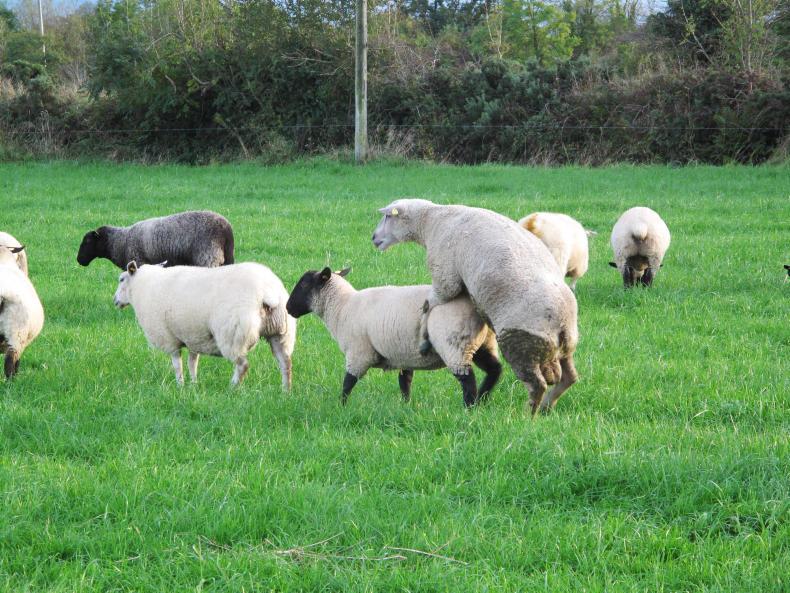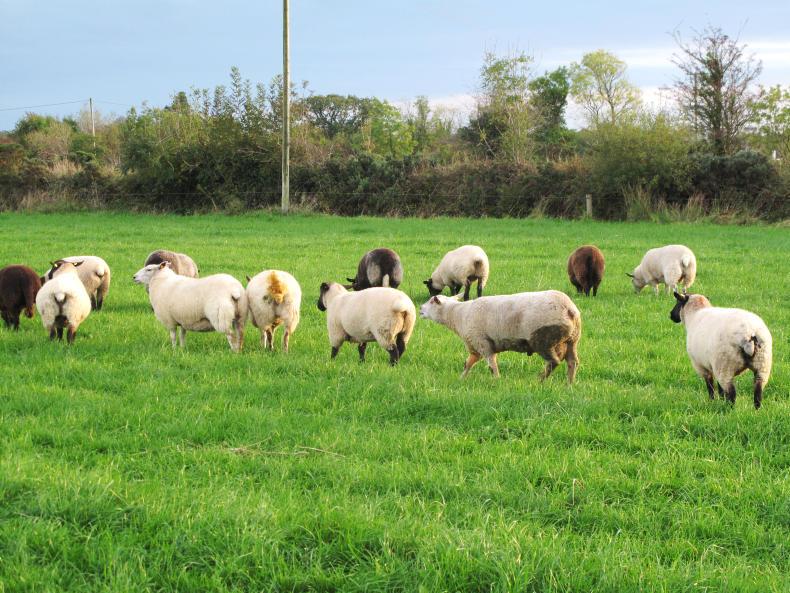Breeding has kicked off or is about to get under way in a high percentage of mid-season lambing flocks.
Ewes are generally in prime condition for breeding, which should also deliver a benefit in ewes coming into season in quick succession.
In the short term, this could put pressure on rams where there is a high ewe-to-ram ratio.
This can be particularly problematic where ram lambs are coming off a high-concentrate diet and joined with ewes without an acclimatisation or transition period to a grass-based diet.
Ram lambs ideally should not be mated with ewe lambs
In such a situation, the ewe to ram ratio may, unfortunately, need be reduced to one ram lamb to 25 to 30 ewes.
Ram lambs ideally should not be mated with ewe lambs, as mature rams are more experienced in seeking out sheep in heat.

Ewes and rams should be observed to ensure that the ram is serving ewes correctly.
It is important at the start of breeding to monitor the performance and breeding activity of rams to ensure ewes are being served correctly.
Serving
It is not unknown for rams to appear to be serving ewes correctly, including raddling, but not actually mating satisfactorily. The only way this will be picked up is by spending some time observing mating.
The greatest fault is rams mounting ewes as normal, but not actually serving. This can be an issue with inexperienced rams or it can also be an issue with rams that are lame in the back legs.
In this instance, mating cannot carried out due to pain being exacerbated when rams mount ewes and pressure comes on the point of pain.
Fertility issues
Running rams in groups will help guard against fertility issues, with the exception of two rams being run in a group and a dominant ram preventing others from mating.

The ewe-to-ram ratio should take into account the age and condition of rams and if ewes are likely to be in heat in quick succession which could add further pressure.
Raddling rams is the easiest method of picking up fertility problems and should ideally be operated both where running rams individually and in groups.
This is particularly important where single-sire mating is practised. A recommended approach to lessen the potential impact of infertility where practising single-sire mating is also to switch rams where possible between groups after each cycle.
This is likely to give the best balance between achieving the aim of mating a particular ram with a batch of ewes for breeding reasons and reducing the risk of problems being identified and lambing being pushed out too far.
Read more
Getting breeding right in your flock
Getting the best results from footbaths
Breeding has kicked off or is about to get under way in a high percentage of mid-season lambing flocks.
Ewes are generally in prime condition for breeding, which should also deliver a benefit in ewes coming into season in quick succession.
In the short term, this could put pressure on rams where there is a high ewe-to-ram ratio.
This can be particularly problematic where ram lambs are coming off a high-concentrate diet and joined with ewes without an acclimatisation or transition period to a grass-based diet.
Ram lambs ideally should not be mated with ewe lambs
In such a situation, the ewe to ram ratio may, unfortunately, need be reduced to one ram lamb to 25 to 30 ewes.
Ram lambs ideally should not be mated with ewe lambs, as mature rams are more experienced in seeking out sheep in heat.

Ewes and rams should be observed to ensure that the ram is serving ewes correctly.
It is important at the start of breeding to monitor the performance and breeding activity of rams to ensure ewes are being served correctly.
Serving
It is not unknown for rams to appear to be serving ewes correctly, including raddling, but not actually mating satisfactorily. The only way this will be picked up is by spending some time observing mating.
The greatest fault is rams mounting ewes as normal, but not actually serving. This can be an issue with inexperienced rams or it can also be an issue with rams that are lame in the back legs.
In this instance, mating cannot carried out due to pain being exacerbated when rams mount ewes and pressure comes on the point of pain.
Fertility issues
Running rams in groups will help guard against fertility issues, with the exception of two rams being run in a group and a dominant ram preventing others from mating.

The ewe-to-ram ratio should take into account the age and condition of rams and if ewes are likely to be in heat in quick succession which could add further pressure.
Raddling rams is the easiest method of picking up fertility problems and should ideally be operated both where running rams individually and in groups.
This is particularly important where single-sire mating is practised. A recommended approach to lessen the potential impact of infertility where practising single-sire mating is also to switch rams where possible between groups after each cycle.
This is likely to give the best balance between achieving the aim of mating a particular ram with a batch of ewes for breeding reasons and reducing the risk of problems being identified and lambing being pushed out too far.
Read more
Getting breeding right in your flock
Getting the best results from footbaths








 This is a subscriber-only article
This is a subscriber-only article









SHARING OPTIONS: